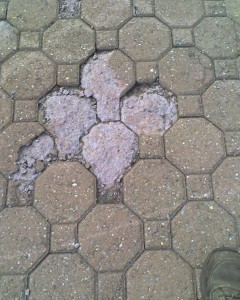As we look out of our office window at the poor mum plants that were damaged by the early snow of October 29 and see new growth popping out due to the unusually mild weather for mid-December, it’s hard getting my thoughts together about winter. But Mother Nature is out there, waiting patiently to slam us again soon, and we would be wise to get ready. If you use a snow management service, you should already have your contracts in place. If not, you should be having your snowblowers serviced, buying your shovels, hats and gloves, and stocking up ice melting products, the most familiar of which is that ancient mineral, salt.
There is something so basic and primal about salt. It regulates our body systems, preserves our food, and is so plentiful that it has been estimated that salt deposits under the state of Kansas alone could supply the entire world’s salt needs for the next 250,000 years. It was prized like gold by the early Romans because it was so hard to come by, and was even used as payment. (Caution – word origin lesson! The word ‘salary’ comes from the Latin ‘salarium’, which refers to the giving or receiving of salt.) Salt is mentioned many times in the Bible, and is still used before Sumo wrestling matches to purify the ring. It is said to have healing and balancing properties when we bathe in it, and claims have been made that it releases air-cleansing ions when heated. I keep a Himalayan crystal salt candle holder on my desk, and I can’t verify any truth to the claim, nor am I exactly sure that I believe it. At the very least, it has a very pretty look and makes for some interesting conversation.
In spite of all the good things we can say about salt, the mineral has its destructive side. We are all familiar with salt’s role in high blood pressure. But did you know that excess salt is also bad for your lawn, trees and hardscape? Too much of it can destroy concrete and paver blocks, or cause damage to grass and tree roots. All de-icing products can have a damaging effect on concrete and pavers, and there are differing opinions and studies out there regarding which one is better, salt, calcium chloride or magnesium chloride. But salt attracts water by its very nature (any woman who is susceptible to water weight can tell you that…) and the water and melting that occurs can seep into tiny cracks in the concrete and blast it apart when it refreezes.
We had the opportunity to see the damaging effects of salt on our trip to Alaska this summer. Nowhere was it more evident than driving up the George Parks Highway from Anchorage, where the Great Alaskan Earthquake of 1964 split the landscape and dropped it as much as 10 feet. The ensuing tsunami left the land inundated with salt water, flooding the trees’ root systems and killing off all of the vegetation for more than 50 miles inland from the coast. “Ghost forests” of dead spruce trees stand like eerie soldiers along the highway, preserved by the salt that killed them. It has been almost 50 years since the earthquake, and the area still has not recovered, mainly because there is still so much salt residue in the ground that it is not hospitable to growth.
The worst part about salt’s effects on our property is that once things are covered in snow, we rarely see them until the damage has already been done. So how do we keep our lawns, landscapes and hardscapes from experiencing the ravaging effects of salt? Prevention. It seems to be a recurring theme in my blogs. As much as we at Horizon Landscape are in business to make money, we are homeowners too, and appreciate advice on how to save money. The best way to save money is to prevent the damage in the first place – it costs far less to prepare than it does to repair.

On paver blocks and concrete surfaces, do not allow de-icing products of any kind to sit in piles, and be sure to hose them off as much as possible. If water isn’t handy, at least sweep up the excess product. Don’t sweep it into your flower beds or toss it on your lawn – pick it up and throw it away. As far as your lawn and landscape is concerned, most salt damage occurs along the curb line, kicked up by municipal snowplows or along the sides of your driveways and walkways, and there’s not a whole lot you can really do about it. Since road salt raises the pH of the soil, you will want to neutralize it with an application of lime or gypsum. Then as soon as the ground is warm enough to grow seed, have the blighted areas renovated, and the lawn will look as good as new in no time. If you have shrubs and trees along your curb and driveway, you can find a list of salt-resistant plants here.
As with all ice-melt products, it’s important that you use them sparingly. Only use as much as you need to get the job done effectively, and your damage should be minimal. And as always, if we can help with any of your snow service needs or concerns, please contact us. Winter is approaching quickly, and there’s just no substitute for being prepared to handle it.
